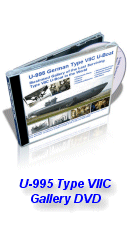

|
Radar Warning Receivers
By mid-1942, allied aircraft had been appearing too often for it to be due to visual sighting. U-boats crossing the Bay of Biscay were attacked by aircraft even at night and in total darkness with unheard of precision. Donitz concluded correctly that radar was to blame, but the final proof came in on one occasion when a U-boat detected an allied aircraft flying low in almost total darkness. No precautions were necessary as visibility was too low for the aircraft to spot the surfaced U-boat. Then just as the aircraft passed by, it suddenly banked and turned on its powerful Leigh lights. The comforting darkness was suddenly pierced by a beam of light, shining directly at the U-boat. As the aircraft made its attack run with guns blazing and rockets firing, the U-boat sustained damage, but managed to limp back to port to tell the story. This confirmed German suspicions that the allies had developed a new airborne radar capable of detecting surfaced U-boats.
It became essential that a warning device be developed quickly which would warn when a U-boat had been illuminated on allied radar. The Germans rushed several radar warning receivers into service, and several of them had been of dubious value as it not only warned of enemy radar, but also caused by much confusion that the Allies were able to home in on the signals emitted.
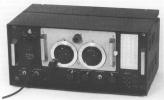
|

|
| Metox, the first radar warning receiver. | Aircraft such as this RAF Liberator were equipped with the ASV Mk III airborne radar. Note the radar dome beneath the nose. |
FuMB-1 Metox
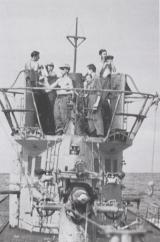
Metox, named after its French inventor Metox Grandin was a VHF receiver operating in the 1.3 to 2.6 meters band, which coincidently was the same as the British ASV Mk 1 radar operating in the 1.4 meters band. The set was mounted in the radio room, where an antenna was extended out onto the conning tower. This rudimentary antenna, known as the Biscay Cross consisted of two pieces of wood tied together into a cross, with wires wrapped around where it had to be carried through the hatch every time the boat surfaced or dived. It was installed into a bracket on the conning tower and periodically the position had to be rotated by hand. The operator would constantly tune in across the frequency band and the device generated an audible warning which was broadcasted on the boat’s loudspeakers when signals were detected in the coverage band. Metox however could not differentiate between radar and non-radar signals, neither could it provide the bearing of the source of transmission.
The Metox was considered so important that it was immediately rushed into service beginning in August 1942. An additional petty officer was assigned in the radio room to operate it. However like all newly developed equipment, problems were encountered with the implementation.
After Metox had entered service, U-boat crews found that allied aircraft had appeared even more frequently. By early 1943, it was apparent that despite the widespread use of Metox, allied aircraft were appearing too often, and were forcing U-boats to submerge and travel underwater. The German technical intelligence sought to find the reason behind the strange phenomenon, and found that the device itself transmitted a frequency which could be picked up for miles around. This led to suspicions that the allies used the frequency as a means of homing in on U-boats and on July 31st 1943, Donitz issued a directive that the Metox was to be used sparingly.
The British were indeed trying to home in on the signals, but had abandoned all efforts as it proved too difficult. Unknown to the Germans, the real reason behind the increase in aircraft appearance was due to the introduction of the new British ASV MkIII radar.
Later on August 13, a British prisoner-of-war under interrogation deceived the Germans by informing that the British were indeed homing in on Metox signals. This led to the order to ban the use of Metox altogether.
FuMB-9 Wanze
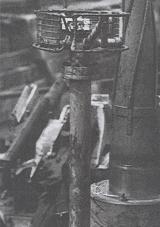
Wanze was developed by Hagenuk, a German electronics company as a further evolution of the Metox, where it automatically scanned radar frequencies in the range between 120 to 180cm. Fine tuning however, was still required to be performed by an operator. The antenna was known as Runddipol (round dipole) and consisted of two vertically polarized poles mounted on a cylinder. The top of the cylinder was enclosed in a cylindrical wire mesh frame, resembling somewhat like a wire basket.
Wanze entered service on August 1943, which was the same time Metox was banned. It had some initial success, but by the following months of September and October, Wanze too had failed to provide early warning of allied aircraft. The ineffectiveness, coupled with several surprise attacks on U-boats equipped with Wanze led to the device being banned on November 5, 1943.
FuMB-10 Borkum
Borkum was introduced immediately after Wanze was banned, and was intended as a stop-gap measure until a more reliable device became available. It was a very simple device with a crystal amplifier attached to a radio receiver. When allied radar frequencies were detected, it simply gave an audible warning on the boat’s loudspeakers. It had very limited range and could not indicate the direction the aircraft was approaching from. Further, it was also unable to detect the new allied ASV Mk III radar. Despite its limited functionality, Borkum continued to be used up to the end of the war.
FuMB-7 Naxos
Unknown to the Germans, the British had developed a new ASV radar which operated in the centimeter wavelength. German scientists had considered this impractical and had so far tuned radar warning receivers to meter wavelengths. It was not until early 1942, when the wreckage of a RAF Stirling bomber shot down over Rotterdam was examined, that the new British 10cm H2S radar was discovered. Apparently this information was confined to the Luftwaffe and did not reach the Kriegsmarine until December 1943.
The Naxos was developed by Telefunken and although it was designed to detect the ASV Mk III radar, but the device covered between 8cm to 12cm wavelengths, enabling the RAF H2S radar to be detected as well. Its antenna consisted of a parabolic reflector which was commonly referred by its nickname “Fliege”, due to its similar resemblance to a bow-tie. As with the Metox antenna, Fliege was not watertight which meant it had to be stowed below deck before submerging. The parabolic shape of the antenna meant that it could cover a wide horizontal arc, but it was limited to a 10 degrees vertical coverage. It was mounted on a bracket atop the conning tower and had a mechanical linkage for it to be hand rotated by the crew in the radio room.
The Naxos was a reliable unit, and later versions were even capable of indicating the direction of approaching aircraft, but the short detection range of 5,000 meters meant that U-boats had only one minute’s warning. The British quickly became aware of the Germans new capability, and as newer generations of British radars were developed to counter the Naxos, the Germans continued to improve the device.
Another noteworthy mention is the FuMB-28 Naxos ZM. Essentially the same set, except for the antenna which rotated at 1,300rpm with the output being displayed on a cathode ray tube, providing a 360 degree visual coverage. This was still under development when the war ended.
FuMB-26 Tunis
A further advanced radar warning device, the Tunis covered the 3cm band which was used by US radar. The antenna was horn shaped, and as with the Fliege, it covered a wide horizontal arc and a narrow vertical area. To save bridge space, Fliege and the Tunis’s antenna were mounted back-to-back on a single pole. The watchcrew still had to periodically rotate the antenna and it had to be taken below deck every time the boat submerged. Tunis entered service in May 1944.
FuMB-29 Bali
Bali was a watertight, multi-directional antenna which was permanently mounted on a bracket atop the bridge. It consisted of a polarized pole enclosed in a cylindrical wire mesh frame.
FuMB-35 Athos
Athos was the final radar warning receiver set developed during the war. The electronics were much more sophisticated with the output being displayed on a cathode ray tube. A further advantage was that the antenna was watertight. This was installed on several Type XXIs just before the war ended.
(FuMB = Funkmess-Beobachtungs-Gerat = radar warning apparatus)
| Photo Gallery | |||
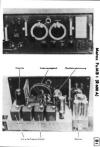 German Metox |
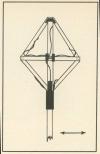 Biscay Cross |
 Biscay Cross |
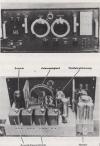 Metox Large |
 German Metox |
 Naxos Antenna with cover removed |
 Naxos Configuration |
 Naxos Diagram |
Particular thanks to Research Collaborator Robert Langille; for these Metox and Naxos photos and whose research has covered both Radar and Electronics Warfare from its early origins to today.
Please visit his website at Electronic Warfare Consulting Services
Many thanks also goes to Mr. Arthur Bauer whose research into Metox and HFDF equipment has made all these information available.



